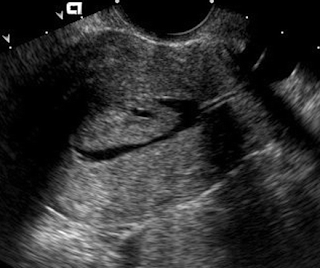The major categories of the FIGO classification are as follows:
Stage 0 – Carcinoma in situ
Stage I – Invasive carcinoma that is strictly confined to the cervix
Stage II – Locoregional spread of the cancer beyond the uterus but not to the pelvic sidewall or the lower third of the vagina
Stage III – Cancerous spread to the pelvic sidewall or the lower third of the vagina, and/or hydronephrosis or a nonfunctioning kidney that is incident to invasion of the ureter
Stage IV – Cancerous spread beyond the true pelvis or into the mucosa of the bladder or rectum
The FIGO stages are further categorized as follows:
Stage Ia cervical carcinoma – Preclinical invasive carcinoma that can be diagnosed only by means of microscopy
Stage Ib cervical carcinoma – A clinically visible lesion that is confined to the cervix uteri
Stage Ib1 – The primary tumor is not greater than 4.0 cm in diameter.
Stage Ib2 – The primary tumor is greater than 4.0 cm in diameter.
Stage IIa cervical carcinoma – Spread into the upper two thirds of the vagina without parametrial invasion
Stage IIb cervical carcinoma – Extension into the parametrium but not into the pelvic sidewall
Stage IIIa cervical carcinoma – Extension into lower one third of the vagina, without spread to the pelvic sidewall
Stage IIIb cervical carcinoma – Extension into the pelvic sidewall and/or causes a nonfunctioning kidney or hydronephrosis due to invasion of the ureter
Stage IVa cervical carcinoma – Extension of the tumor into the mucosa of the bladder or rectum
Stage IVb cervical carcinoma – Spread of the tumor beyond the true pelvis and/or by metastasis into distant organs
The strict FIGO clinical staging guidelines do not include the status of the lymph nodes, although the presence of metastatic adenopathy is an important factor in treatment planning and in the prognosis.
Extended clinical staging with cross-sectional imaging (CT scanning and/or MRI) includes the status of the lymph nodes in the assessment of the extent of the disease. The detection of enlarged pelvic lymph nodes is considered equivalent to pelvic sidewall tumor extension (stage III), and the detection of enlarged lymph nodes in the para-aortic, paracaval, or inguinal regions is considered extrapelvic tumor spread (stage IV).
The major limitations of the FIGO clinical staging system are encountered in the estimation of the size of the primary tumor, particularly when the tumor is endocervical. The size of the tumor is significant because, in each stage, the incidence of lymph node metastases increases and the prognosis deteriorates with increased volume of the primary tumor.
Other limitations occur in the evaluation of tumor extension into the parametrium and pelvic sidewalls and in the detection of metastatic lymphadenopathy or distant metastasis.Extended clinical staging with cross-sectional imaging (CT scanning and/or MRI) and surgicopathologic staging, including pelvic and abdominal retroperitoneal lymphadenectomy, provide additional diagnostic value.
Each has been proven to be superior to the conventional FIGO clinical staging system in determining the full extent of the tumor spread. However, once the clinical stage is assigned on the basis of the clinical pretreatment workup results (in compliance with the FIGO guidelines), the stage should not be altered as a result of subsequent findings. Instead, any additional information that is revealed by cross-sectional imaging or surgery is primarily used for planning treatment regimens, and they should not be used to revise the assigned clinical stage.
http://emedicine.medscape.com/article/402329-media
 a
a b
b c
c

















































